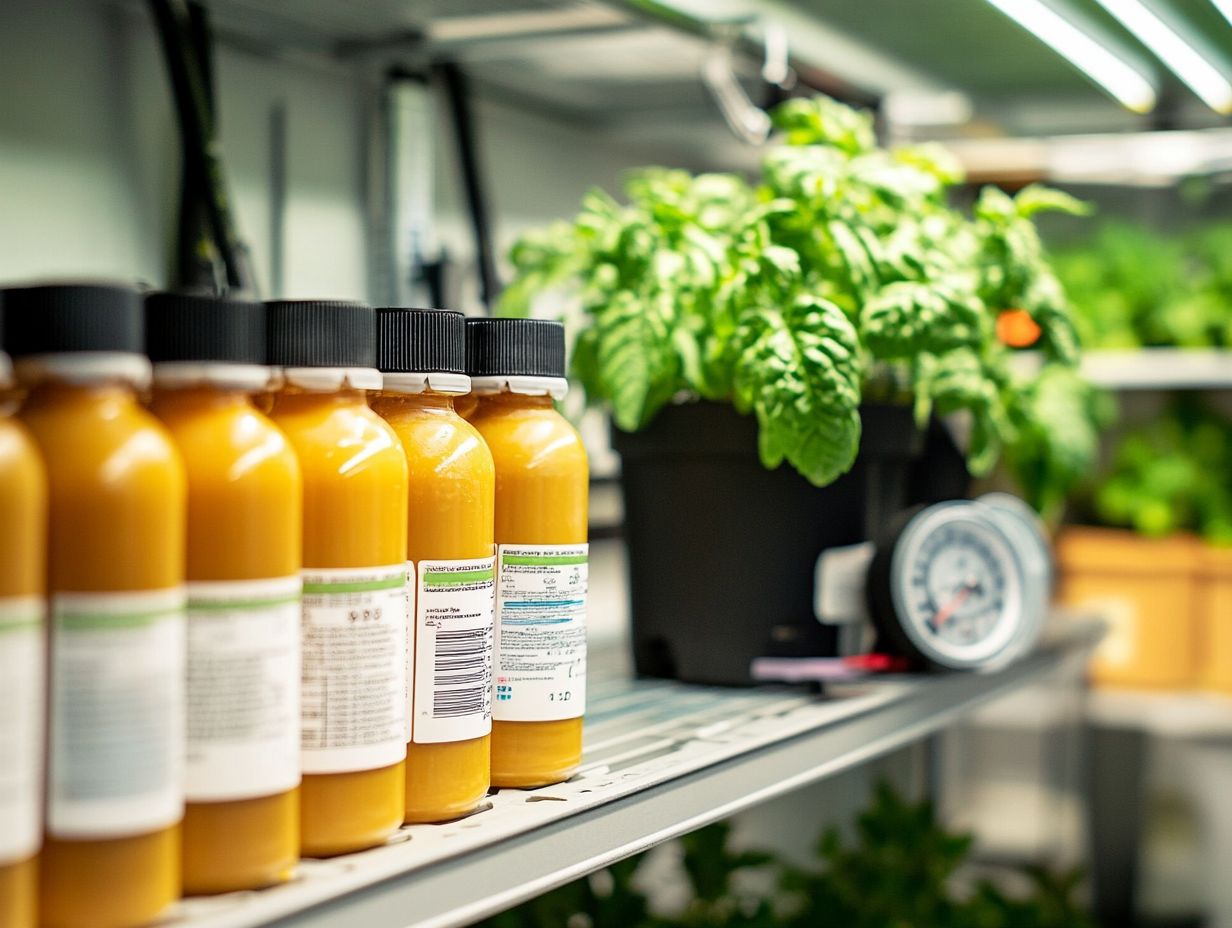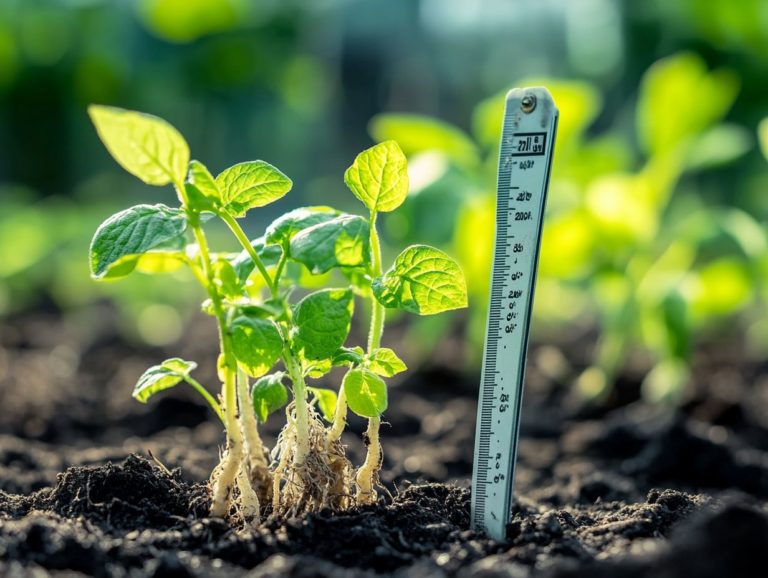How to Store Hydroponic Nutrients Properly
Hydroponic gardening places great emphasis on nutrient solutions, which are vital for achieving optimal plant growth. Dive in to discover how to keep your hydroponic nutrients fresh and effective!
This article delves into what hydroponic nutrients are and examines how their storage conditions can significantly influence plant health. You’ll discover best practices for storing these essential nutrients, identify signs of improper storage, and explore alternative methods that can elevate your hydroponic garden experience.
Join in as you uncover the most effective strategies for maintaining your hydroponic nutrients in peak condition, ensuring effective plant care!
Contents
- Key Takeaways:
- Why Proper Storage is Important
- Best Practices for Storing Hydroponic Nutrients
- Signs of Improperly Stored Nutrients
- Alternatives to Traditional Storage Methods
- Frequently Asked Questions
- What is the best way to store hydroponic nutrients properly?
- Can hydroponic nutrients be stored for a long period of time?
- What is the ideal temperature for storing hydroponic nutrients?
- Should I store hydroponic nutrients in the refrigerator?
- Is it necessary to label and date hydroponic nutrient containers?
- How often should I check and replace stored hydroponic nutrients?
Key Takeaways:

- Proper storage of hydroponic nutrients is crucial for optimal plant growth and health.
- Use proper containers and storage locations to prevent nutrient degradation and contamination.
- Identifying and addressing nutrient issues can be easy when following best storage practices.
What are Hydroponic Nutrients?
Hydroponic nutrients are absolutely essential for the growth and health of plants thriving in soilless systems. In hydroponics, nutrient solutions deliver vital elements directly to the roots, giving you precise control over what your plants receive.
This means you can optimize growth conditions, ensuring your plants get the right main nutrients like nitrogen, phosphorus, and potassium, along with essential micronutrients for vibrant health. Brands like Advanced Nutrients and General Hydroponics offer tailored solutions that cater to different crop types, effective for both novices and seasoned growers.
These specially formulated solutions stand in stark contrast to traditional soil nutrients, which can be unpredictable and susceptible to leaching or depletion over time. Hydroponic nutrients typically feature readily available forms of nitrogen, phosphorus, and potassium, along with trace elements like iron and magnesium, making them far more efficient for uptake.
You have the ability to fine-tune nutrient concentrations and pH levels in your hydroponic systems, ensuring optimal nutrient absorption that caters specifically to your plants’ needs, whether they are leafy greens or fruiting crops.
This level of precision not only fosters healthier growth but can also accelerate harvest times and boost yields, making hydroponic systems an increasingly attractive option for modern farmers.
Why Proper Storage is Important
Proper storage of hydroponic nutrients is crucial for maintaining their efficacy and ensuring optimal plant growth, as environmental factors can greatly influence their stability and quality.
By implementing suitable facility storage solutions and closely monitoring water quality, you can effectively prevent nutrient degradation that could jeopardize plant health and improve your commercial agriculture practices.
Using environmental meters helps you track critical conditions, ensuring your nutrients remain in prime condition for nutrient mixing and application.
Impact on Plant Growth and Health
The significance of properly stored hydroponic nutrients on your plants’ growth and health is immense; they directly shape your plants’ ability to thrive and develop robustly.
Nutrients are critical for various physiological processes, including photosynthesis, respiration, and nutrient uptake, all essential for achieving a healthy, productive harvest.
By maintaining the quality of these nutrients, you can prevent common nutrient-related issues that lead to stunted growth or deficiencies. Understanding your plants’ specific needs at different growth stages is paramount, as nutrient requirements can vary significantly.
A balanced nutrient solution ensures that your plants receive the right amounts of main nutrients and essential micronutrients. Regular monitoring is essential; it allows you to make timely adjustments to nutrient solutions, ensuring optimal absorption and reducing the risk of toxic build-up.
Stay vigilant to boost plant health and increase your yield potential, resulting in a vibrant and flourishing garden or crop.
Properly stored nutrients lead to thriving plants and bountiful harvests!
Best Practices for Storing Hydroponic Nutrients

Best practices for storing hydroponic nutrients are essential. They help preserve longevity and effectiveness for robust plant growth.
Utilizing proper containers such as opaque or UV-blocking storage tanks helps prevent light exposure that can degrade these valuable nutrients. Maintain optimal environmental conditions, including temperature and humidity, to safeguard nutrient integrity.
An organized storage system ensures easy access to your nutrients. This also makes nutrient mixing efficient whenever necessary.
Proper Containers and Conditions
Using correct containers and keeping optimal storage conditions are vital. They ensure your hydroponic nutrients remain effective and safe for your plants.
You have various container options, such as high-density polyethylene (HDPE) or glass, both known for their non-reactive properties. Choose a container size wisely; if it s too large, frequent exposure to air can increase the risk of contamination.
By selecting materials that prevent leaching and ensuring optimal conditions like cool, dark storage areas, you can significantly extend the shelf life of your nutrients. For a deeper understanding of how to maintain nutrient quality, check out understanding hydroponic nutrient solutions. Leaching means materials leaking from containers, which can harm nutrient quality.
On the flip side, improperly chosen storage containers can compromise the quality of your nutrients. This can lead to chemical interactions that diminish their effectiveness or even introduce harmful substances into your solutions, affecting your commercial horticulture efforts. To prevent this, consider understanding hydroponic nutrient solutions for better management.
Recommended Storage Locations
Choosing the right storage locations is crucial! Keep your hydroponic nutrients away from direct sunlight, high-traffic zones, and extreme temperature fluctuations to prevent any degradation of your solutions.
Utilizing climate-controlled rooms can significantly enhance the longevity of your nutrients. They maintain a consistent temperature and humidity level two key factors in preventing spoilage.
Dark storage cabinets can offer a safe haven, shielding your vital nutrients from light exposure that could lead to degradation. By carefully selecting these storage spots, you preserve the integrity of your nutrients and optimize the workflow within your facility.
Keeping your storage facilities close to the hydroponic systems allows for seamless transitions during nutrient mixing, ultimately streamlining your operational productivity.
Signs of Improperly Stored Nutrients
Identifying signs of improperly stored nutrients is crucial. Look for signs like cloudy solutions or unusual colors. These could mean your nutrients have degraded.
If your plants show signs of nutrient deficiencies or toxicities, act fast! It may be time to check your nutrient quality. This situation demands your immediate attention and calls for corrective measures to restore balance and vitality to your plants.
Identifying and Addressing Nutrient Issues

Identifying and addressing nutrient issues is crucial for your hydroponic plants’ health and productivity. Look out for signs such as yellowing leaves and stunted growth; these indicate nutrient imbalances.
Regular evaluations of your nutrient solutions and plants help you spot deficiencies or toxicities. This allows you to make timely adjustments and restore your plants vitality.
For instance, magnesium deficiency shows up as yellowing between the veins of older leaves. On the other hand, a nitrogen deficiency causes overall yellowing and poor leaf growth.
Consider using nutrient testing kits. These kits help you measure nutrient levels accurately, ensuring your plants get exactly what they need. Implementing solutions like tailored nutrient mixes or foliar sprays ensures your plants receive essential elements for robust growth.
Regular monitoring and proactive care are key components in creating an optimal growing environment.
Alternatives to Traditional Storage Methods
Exploring new ways to store hydroponic nutrients can boost your efficiency and sustainability today! Imagine significantly improving your plant care practices.
Embracing technologies like automated control systems allows you to monitor and adjust nutrient solutions in real time, minimizing waste and ensuring optimal conditions for plant growth.
Consider using environmentally friendly options like biodegradable materials and compost tea. These choices help you adopt sustainable practices while maintaining high-quality hydroponic systems.
Exploring New Technologies and Solutions
The exploration of new technologies in nutrient storage and management, including the use of Nutrient Calculator tools, is transforming the hydroponics industry. These innovations significantly enhance nutrient mixing processes and improve plant care outcomes.
With automated control systems, you can make real-time adjustments to the nutrient solution tailored to your plants’ specific needs. This ensures they receive the precise plant nutrients required for optimal growth.
Environmental meters enable you to monitor vital parameters, allowing informed decisions regarding nutrient application and storage.
These innovations streamline your workflow and minimize waste, as highlighted in articles from Chicago Tribune and TimeOut Magazine. For example, precise nutrient delivery helps prevent over-fertilization, conserving resources and safeguarding plant health.
By integrating data analytics and insights from University of Wisconsin-Madison, you can identify trends and optimize your nutrient management schedules.
This leads to operational efficiency and enhances yield quality and consistency, often discussed in expert interviews for best practices in interior plantscaping. This technology-driven approach allows you to meet market demands more effectively while contributing to sustainable practices in agriculture.
Frequently Asked Questions
What is the best way to store hydroponic nutrients properly?

The best way to store hydroponic nutrients is in a cool, dry, and dark place. This prevents nutrient breakdown and keeps them effective.
Seal the packaging well to avoid exposure to moisture and air, especially when using agricultural tanks for storage.
Feel free to share your experiences or questions in the comments below!
Can hydroponic nutrients be stored for a long period of time?
Yes, hydroponic nutrients can be stored for a long time if stored properly. Use them within 1-2 years of purchase for the best results.
What is the ideal temperature for storing hydroponic nutrients?
The ideal temperature for storing hydroponic nutrients is between 50-70 degrees Fahrenheit. This range helps prevent nutrient breakdown, meaning the nutrients lose their effectiveness over time, and maintains their potency.
Should I store hydroponic nutrients in the refrigerator?
Do not store hydroponic nutrients in the refrigerator. Temperature fluctuations and moisture can affect the nutrients’ potency and may cause spoilage.
Is it necessary to label and date hydroponic nutrient containers?
You should label and date your hydroponic nutrient containers. This ensures easy identification and helps you keep track of expiration dates, so you re always using fresh nutrients.
How often should I check and replace stored hydroponic nutrients?
Check your stored nutrients every 3-6 months to ensure they re fresh and effective! Don t wait until they are expired replace them if they are past their expiration date or show signs of spoilage.






